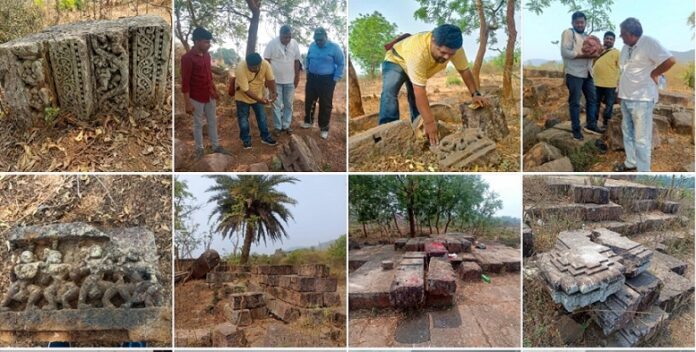
By Our Correspondent
CUTTACK/BHUBANESWAR: A team from the Indian National Trust For Art & Cultural Heritage (INTACH) has discovered the base of an ancient temple and other archaeological remains at Purushottampur Sasana village in the Badachana block of the Jajpur district. The temple ruins, near the Dhanamandal Railway Station, was first noticed by Nrupati Nihar Siala, a local heritage enthusiast, who informed the INTACH Cuttack Chapter. The ruins lay scattered in an area of four acres at the base of a small hillock, a little away from the railway siding.
The three-member INTACH team, comprising Anil Dhir, Biswajit Mohanty, and Deepak Kumar Nayak explored the spot and the vicinity along with Bikram Kumar Nayak and Suman Prakash Swain.
According to Deepak Kumar Nayak, the ruins are suggestive of a large temple complex that had crumbled down due to unknown reasons. However, the base of the temple is still clearly visible. A large number of huge stone blocks, intricately carved stone panels, and few religious sculptures are found scattered all around the site.
The most notable stone panels are the depictions of war processions, musical bands, royal processions, palanquins, elephants etc. A Kalasa of a temple was found at the dug-up site of the railway station. Considering this iconography, he assigns the construction period to be around the 13th/14th Century C.E, the period when the Eastern Ganga Dynasty held sway over the region.
Dr. Biswajit Mohanty is of the opinion that the Jajpur region was known as ‘Guheswarapataka’ in ancient times. The region was ruled by powerful dynasties like the Bhaumakaras, Somavamsis, Gangas and Suryavamsis. Art and architecture touched the pinnacle of finesse during the rule of these dynasties.
Many beautiful temples of the Kalingan order were built during the glorious reigns of the Kings. Many of these came under the onslaught of attacks by the iconoclastic marauders which included Firoz Shah Tughlaq, Kalapahada and Aurangzeb. The region of Jajpur witnessed a cultural genocide with the destruction of many temples and mutts. This temple at Purushottampur too must have been destroyed during any such attacks.
Many artifacts were also found in the excavated area of the ongoing railway work near the station. While most of the square blocks have been removed by the villagers for construction, there are nearly a thousand odd pieces scattered lying all over the complex. The team a saw many that have been overrun by the dense undergrowth bushes and vegetation. The temple base, till the Pista level, is practically intact, with very large stone blocks.
According to Anil Dhir, Project Co-ordinator of INTACH, the presence of many small forts in the vicinity are indicative of a large habitation in the early days. Many archaeological remains from Eastern Ganga’s era have been discovered in the nearby forts of Amaravati, Teligada and Darpanagada. Earlier, the nearby villages of Teligada and Dharmasala had yielded the Rathayatra stone panel and a magnificent Krishna-Vishnu image which have been kept at the Odisha State Museum. The archaeological remains and antiquities noticed at this spot are very similar in nature to these.
Dhir insists that a proper archaeological excavation of the site should be undertaken by experts from the State Archaeology Department or the ASI. While most of the embellished stone blocks and images of the ruined temples have been taken away, the few that remain should be removed and kept at the State Museum.
The entire 4-acre complex should be secured by a wall or barbed wire fencing and the place declared as a protected monument. Intach will prepare a preliminary report and submit it to the authorities, with a request to conduct a proper survey of the site and the nearby areas.





























